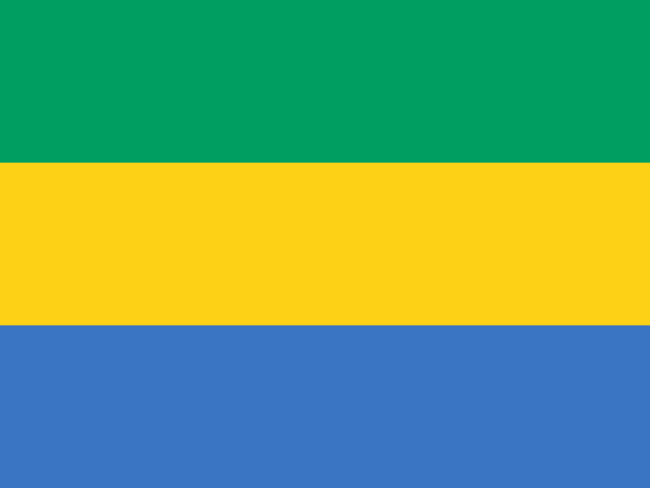Gabon is a country at the Equator in West-Central Africa bordering the Atlantic Ocean in West and is bordered by Equatorial Guinea, Cameroon, and the Republic of the Congo. With an area of 267,668 km², the country is somewhat larger than the United Kingdom, or slightly smaller than the U.S. state of Colorado.
Gabon has a population of estimated 1.5 million people. Capital and largest city is Libreville. Spoken languages are French (official) and a variety of Bantu languages. Because of its oil and mineral reserves and a relatively small population, Gabon is one of Africa’s wealthier nations, which is able to protect and preserve its pristine rain forests with a rich biodiversity.
More than 10% of Gabon’s area is protected parkland, there are 13 National Parks in the country, among them the forested coastal terrain of the Loango National Park, ‘Africa’s Last Eden’ shelters a diversity of wildlife from gorillas and hippos to whales. Lopé National Park consists of mostly rainforest, but in in the north the park contains the last remnants of grass savannas. Akanda Park is known for its mangroves and tidal beaches. Highest mountain in Gabon is Mont Iboundji with 1,575 m.
Background at Gabon
Only two autocratic presidents have ruled Gabon since independence from France in 1960. Gabon’s former President, El Hadj Omar BONGO Ondimba – one of the longest-serving heads of state in the world – had dominated Gabon’s political scene for four decades (1967 2009).
Following President BONGO’s death in 2009, new elections brought Ali BONGO Ondimba, son of the former president, to power.
Business & Economy in Gabon
Gabon is ranked as an upper-middle-income country. As the fifth largest oil producer in Africa, Gabon has experienced strong economic growth over the past decade, driven in particular by its oil and manganese production.
Geography of Gabon
Location: Western central Africa, bordering the Atlantic Ocean at the Equator, between Republic of the Congo and Equatorial Guinea.
Area: 267,667 km² (103,347 sq. mi.)
Terrain: Narrow coastal plain; hilly and heavily forested interior (about 80% forested); some savanna regions in east and south.
Climate: Hot and humid with two rainy (February – May main rainy season) and two dry seasons (May – September main dry season).
People of Gabon
Nationality: Gabonese
Population: 1.5 million (2010 UN estimate)
Ethnic Groups: Over 40 ethnic groups: Fang (34%), Bapounou (22%), M’Bete (14%), Bandjabi (11%), Bakota (6%), and Myene (5%).
Languages: French (official), Fang, Myene, Bateke, Bapounou/Eschira, Bandjabi.
Religions: Christianity, Muslim, animist.
Natural Resources of Gabon
G Petroleum, natural gas, diamond, niobium, manganese, uranium, gold, timber, iron ore, hydropower.
Agricultural Products of Gabon
Cocoa, coffee, sugar, palm oil, rubber; cattle; okoume (a tropical softwood); fish.
Industries in Gabon
Petroleum extraction and refining; manganese, and gold mining; chemicals; ship repair; food and beverage; textile.
Exports – Commodities in Gabon
Crude oil, timber, manganese, uranium
Exports Partners of Gabon
Japan 21.7%, USA 10.7%, Australia 9.7%, India 8.8%, China 8.5%, Spain 6.3%, France 4.3%, Trinidad and Tobago 4.2% (2013)
Imports – Commodities in Gabon
Machinery and equipment, foodstuffs, chemicals, construction materials
Imports – Partners of Gabon
France 21.8%, Cote d’Ivoire 16.6%, China 10%, Belgium 5.6%, US 5.5%, Netherlands 5.1% (2013)
Currency of Gabon
Communaute Financiere Africaine Francs CFA (XAF)
CENTER FOR AFRICAN STUDIES
Center for Africa Studies (AFRAM) which located in Ankara, is an organization facilitating under the administration of African Affairs Council (AFAC). It makes various researches about Africa to enhance economic and cultural bounds between Africa and Turkey. AFRAM’s publishings has been shared with different institutions as they require to obtain.
AFRICA OBSERVATORY
Africa Observatory is one the publishing of AFRAM and it has been published each two weeks. It has been delivered to different institutions via e-mail.






